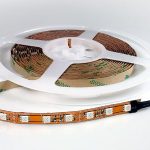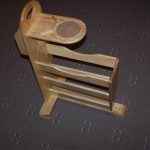We may receive a commission when you use our affiliate links. However, this does not impact our recommendations.
Down the road a few miles from the Atlantic Veneer slicing operation is the Veneer Tech splicing plant. Veneer Tech takes leaves of veneer and assembles them into faces. Think of a 4 x 8 sheet of hardwood plywood, or a sheet of backed veneer. The large faces are assembled then later bonded to a substrate. The beginning of this process is much like the end of the slicing operation. Books of veneer leaves are inspected, trimmed and graded.

This gentleman determines the fate of each book, and the profitability of the operation. In a few moments, he inspects the 12′-long books of veneer and marks them for edge and end trimming. In addition to standard 4 x 8 sheets, veneer faces are also sold as counter-grain faces (with the grain running vertically) and small faces for furniture manufacturers. The books move on from this workstation and are trimmed and sorted.

After trimming, the leaves are loaded on a conveyor and glue is applied to the edges of a stack. It was a surprise to me that full sheets of veneer are glued together edge to edge, and the machinery that makes this possible is an incredible application of technology.

This set of rollers is a few feet beyond the glue applicator, and the leaves are fanned apart to keep the glue on the edges from holding the stack together. The leaves have been kept in books up to this point, and will now travel as individual leaves to the next stage of the process.

This machine is where the assembly of the sheets takes place. The operator loads one leaf at a time against stops on the machine table. For bookmatched sheets, every other leaf will be turned over. When the leaves are loaded, a platen lowers then heat and pressure are applied to activate the glue and bond the leaves to one another, one seam at a time. The mirror behind the platen lets the operator view the entire sheet as it is assembled. Quality control is crucial at this point; one bad leaf can ruin the value of an entire sheet.

The assembled sheets travel to the next station, where they are inspected one at a time. Lights on the table shine through the veneer, making it easy to see any defects. The inspector at this point speaks the grade of each sheet into a microphone, and the grade and a sheet number display on the computer monitor. As the sheets leave this station they travel down the conveyor and are automatically sorted by species and grade.

These pallets contain assembled sheets. Some will be shipped on to plywood manufacturers and some will be backed in house with a paper, veneer or phenolic backing for sale as sheets of veneer. A full pallet will contain about 40,000 square feet of veneer. Veneer Tech sells to plywood manufacturers and to distributors. Even though they move an amazing volume of material each day, they can insert custom runs into their production line on short notice. Next time, we’ll look at how the sheets are backed.
Here are some supplies and tools we find essential in our everyday work around the shop. We may receive a commission from sales referred by our links; however, we have carefully selected these products for their usefulness and quality.









Thanks for the very detailed information. I will so much more appreciate just what I have the next time I use a piece of veneer. The thing that seems so amazing to me is how they can edge glue anything that thin and make it hold.
Again Thanks for the info.